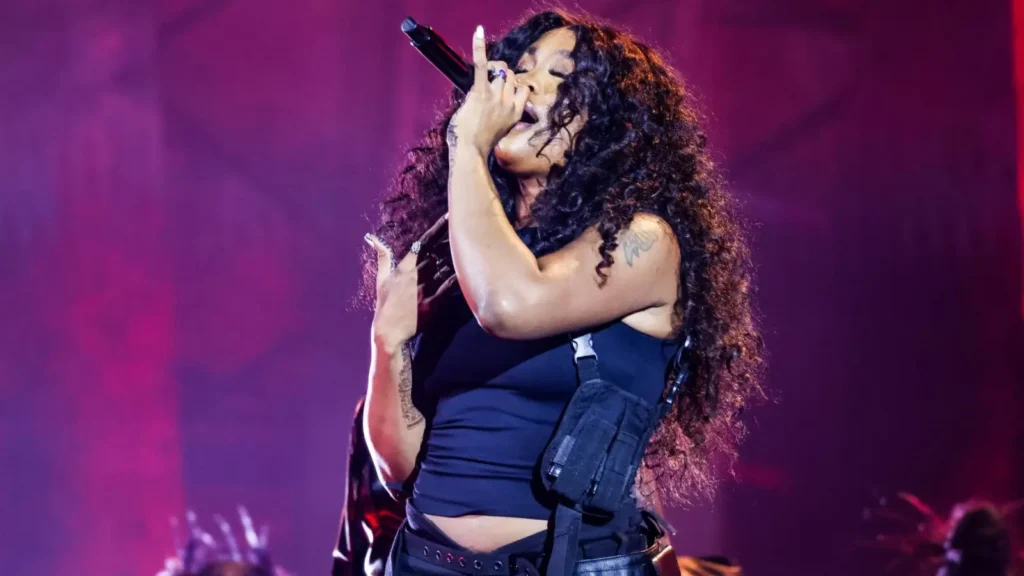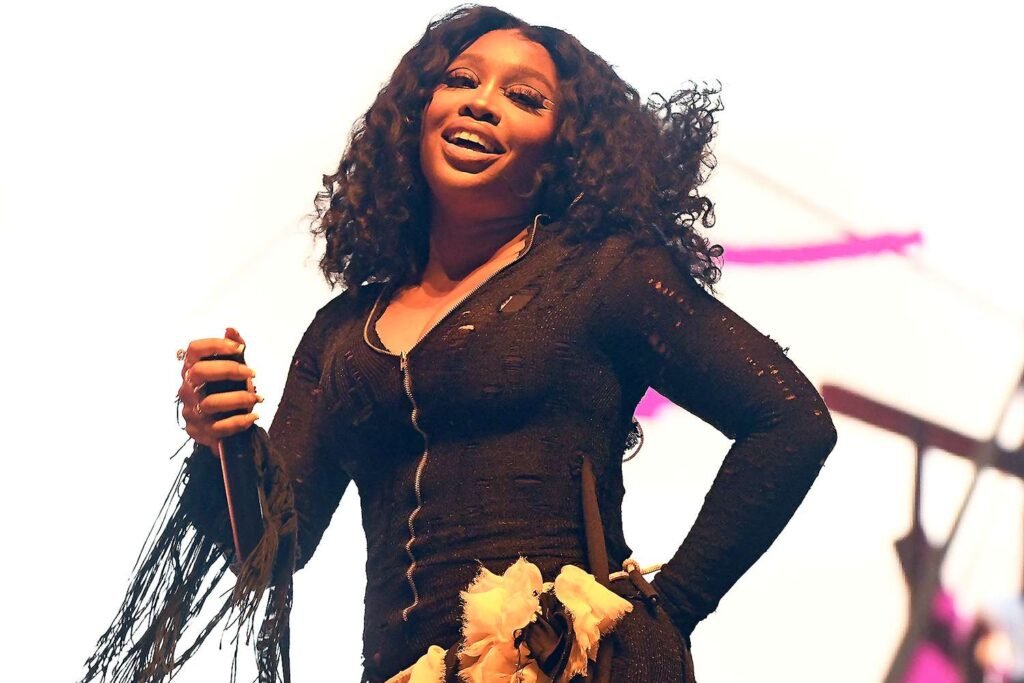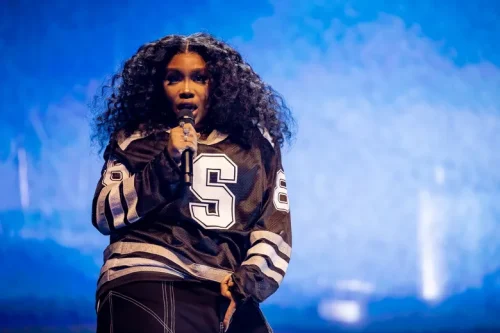In the ever-evolving landscape of modern R&B, few artists have made as profound an impact as SZA. Emerging from the vibrant music scene of the 2010s, SZA has carved out a niche for herself with a sound that defies traditional genre boundaries. Her unique blend of neo-soul, hip-hop, and alternative influences has not only garnered critical acclaim but also resonated deeply with a diverse audience. SZA’s music is characterized by its rich tapestry of electronic beats, atmospheric textures, and deeply introspective lyrics, setting her apart from her contemporaries.
SZA’s debut album, Ctrl, released in 2017, marked a pivotal moment in her career and in the R&B genre. The album showcased her ability to merge the raw emotionality of neo-soul with the rhythmic complexity of hip-hop and the experimental edge of alternative music. This eclectic mix has since become a hallmark of her style, influencing a new wave of R&B artists who seek to push the boundaries of the genre.
The Evolution of SZA’s Sound

Early Influences and Musical Background
Solána Imani Rowe, known professionally as SZA, grew up in Maplewood, New Jersey, surrounded by an eclectic mix of musical influences. Her father’s love for jazz and her mother’s inclination towards old-school soul played a crucial role in shaping her early musical taste. Additionally, SZA was heavily influenced by the alternative sounds of Björk and the soulful melodies of Lauryn Hill, whose seminal album The Miseducation of Lauryn Hill left a lasting impression on her. These diverse influences would later become foundational elements in her unique musical style.
Key Moments in Her Career That Shaped Her Sound
SZA’s journey to musical stardom began in earnest when she released her self-made EP, See.SZA.Run, in 2012. This initial project showcased her raw talent and eclectic style, catching the attention of Top Dawg Entertainment (TDE). Signing with TDE in 2013 was a pivotal moment in her career, providing her with a platform to refine her sound and reach a broader audience.
The release of her subsequent EPs, S (2013) and Z (2014), marked significant steps in her artistic development. These projects demonstrated her evolving style, blending dreamy, ethereal production with confessional lyrics. Her collaborations with label mates like Kendrick Lamar and Isaiah Rashad further honed her ability to merge hip-hop influences with her neo-soul roots.
Overview of Her Discography and Stylistic Progression
SZA’s debut studio album, Ctrl (2017), represents a culmination of her early influences and career experiences. Ctrl was lauded for its honest and vulnerable storytelling, intricate production, and genre-blending sound. Tracks like “Love Galore” and “The Weekend” exemplify her ability to fuse hip-hop beats with soulful melodies and introspective lyrics. The album’s success catapulted SZA to mainstream acclaim, earning her several Grammy nominations and solidifying her place in the R&B landscape.
Following Ctrl, SZA continued to evolve her sound through various high-profile collaborations. Her feature on Maroon 5’s “What Lovers Do” showcased her versatility, while her contributions to the Black Panther soundtrack, particularly the song “All the Stars” with Kendrick Lamar, highlighted her ability to create anthemic, cinematic music.
In 2022, SZA released her highly anticipated sophomore album, SOS. This album further solidified her status as a leading voice in modern R&B. SOS builds on the foundations laid by Ctrl, exploring themes of vulnerability, self-discovery, and resilience. The album features a diverse range of musical styles, from the introspective ballad “Good Days” to the more upbeat and experimental “I Hate U.” The inclusion of electronic beats, atmospheric textures, and SZA’s signature introspective lyrics are prominent throughout the album, showcasing her continued evolution as an artist.
Neo-Soul Foundations

Definition and Characteristics of Neo-Soul
Neo-soul is a genre that emerged in the late 1990s, blending contemporary R&B with elements of soul, jazz, funk, and hip-hop. Characterized by its smooth, organic sound, neo-soul often features rich, live instrumentation, deep grooves, and a focus on vocal and lyrical expression. Artists like Erykah Badu, D’Angelo, and Lauryn Hill are often credited with pioneering the genre, which is known for its emphasis on authenticity and emotional depth. Neo-soul stands out for its ability to seamlessly meld traditional soul influences with modern sensibilities, creating a timeless yet forward-thinking sound.
Analysis of How SZA Incorporates Neo-Soul Elements in Her Music
SZA’s music is deeply rooted in the neo-soul tradition, and she adeptly incorporates its defining characteristics into her own unique sound. Her vocal style is rich and expressive, often conveying a raw emotional honesty that is a hallmark of neo-soul. SZA’s use of live instrumentation, such as guitar and bass, adds an organic quality to her tracks, while her complex vocal arrangements and harmonies showcase her deep understanding of soul music.
SZA also embraces the introspective and personal lyricism that is central to neo-soul. Her songs often delve into themes of love, self-discovery, and vulnerability, reflecting the genre’s focus on personal and emotional expression. By blending these neo-soul elements with modern production techniques and contemporary influences, SZA creates music that feels both timeless and fresh.
Examples of Songs That Highlight Her Neo-Soul Influences
- “Drew Barrymore” from Ctrl (2017)
- This track exemplifies SZA’s neo-soul influence with its laid-back groove and soulful instrumentation. The warm guitar riffs and SZA’s emotive vocal delivery create an intimate and reflective atmosphere, characteristic of neo-soul. The lyrics, which explore themes of self-worth and vulnerability, are deeply personal and introspective.
- “The Weekend” from Ctrl (2017)
- “The Weekend” showcases SZA’s ability to blend neo-soul with contemporary R&B. The song features smooth, jazzy chords and a rhythmic, bass-heavy groove. SZA’s vocal performance is both sultry and expressive, embodying the emotional depth of neo-soul while the modern production gives it a fresh, contemporary edge.
- “Broken Clocks” from Ctrl (2017)
- This song highlights SZA’s neo-soul roots through its soulful melody and organic instrumentation. The layered vocals and harmonies, combined with the introspective lyrics about time and personal growth, reflect the essence of neo-soul. The production, while modern, maintains a warm and organic feel, bridging the gap between traditional and contemporary sounds.
- “Good Days” from SOS (2022)
- In “Good Days,” SZA’s neo-soul influence is evident in the song’s lush, atmospheric production and soulful melody. The track features rich, live instrumentation, including a prominent bassline and intricate guitar work. SZA’s introspective lyrics and emotive vocal delivery convey a sense of longing and hope, resonating deeply with the neo-soul tradition.
SZA’s ability to incorporate neo-soul elements into her music while also embracing contemporary influences sets her apart in the modern R&B landscape. Her deep appreciation for the genre’s roots, combined with her innovative approach to songwriting and production, allows her to create a sound that is both nostalgic and forward-thinking.
Hip-Hop Integration

SZA’s Relationship with Hip-Hop
SZA’s relationship with hip-hop is integral to her musical identity. From the beginning of her career, she has been closely associated with hip-hop, signing with the influential label Top Dawg Entertainment (TDE) in 2013. TDE, known for its roster of prominent hip-hop artists like Kendrick Lamar, ScHoolboy Q, and Jay Rock, provided SZA with a unique platform to blend her R&B and neo-soul influences with the raw energy of hip-hop.
Throughout her career, SZA has collaborated with numerous hip-hop artists, seamlessly blending her vocal style with their distinct flows and rhythms. Notable collaborations include her work with Kendrick Lamar on tracks like “Doves in the Wind” and “All the Stars,” as well as with Travis Scott on “Love Galore.” These collaborations have not only expanded her musical horizons but have also introduced her to a wider hip-hop audience.
How Hip-Hop Rhythms and Production Techniques Are Woven into Her Tracks
SZA’s music frequently incorporates hip-hop rhythms and production techniques, creating a distinctive sound that bridges the gap between R&B and hip-hop. Her use of heavy basslines, crisp snares, and trap-inspired hi-hats adds a rhythmic complexity to her tracks, while her vocal delivery often mirrors the cadence and flow of rap.
Producers like Antydote, ThankGod4Cody, and Carter Lang, who have worked with SZA, bring a hip-hop sensibility to her music. They utilize sampling, beat switches, and layered vocal effects, which are common in hip-hop production, to enhance her songs. This blend of smooth melodies with gritty, beat-driven backdrops creates a dynamic and engaging listening experience.
Case Studies of Specific Songs Featuring Hip-Hop Elements
“Love Galore” featuring Travis Scott from Ctrl (2017)
- “Love Galore” is a quintessential example of SZA’s integration of hip-hop elements. The track features a laid-back, trap-inspired beat with prominent hi-hats and a deep bassline. Travis Scott’s verse adds a rap cadence that complements SZA’s melodic vocal delivery. The interplay between SZA’s smooth vocals and the hip-hop production creates a compelling contrast that defines the song’s unique sound.
“Doves in the Wind” featuring Kendrick Lamar from Ctrl (2017)
- This track showcases a seamless blend of hip-hop and R&B. The minimalist beat, characterized by its punchy drums and sparse instrumentation, allows SZA’s vocals to shine. Kendrick Lamar’s verse adds a dynamic element, with his sharp, rhythmic flow contrasting with SZA’s more fluid singing style. The song’s production, with its use of space and rhythm, exemplifies how hip-hop techniques can enhance an R&B track.
“All the Stars” with Kendrick Lamar from Black Panther: The Album (2018)
- “All the Stars” is a powerful collaboration that highlights SZA’s ability to merge hip-hop and R&B. The song features an anthemic beat with driving drums and lush, cinematic production. Kendrick Lamar’s verses are interwoven with SZA’s soaring chorus, creating a dynamic interplay between rap and melody. The production’s grand scale and rhythmic intensity reflect hip-hop’s influence on the track.
“Power is Power” with The Weeknd and Travis Scott from For the Throne (2019)
- On “Power is Power,” SZA teams up with The Weeknd and Travis Scott to create a track that melds hip-hop and R&B influences. The song’s production features a heavy, trap-influenced beat with dramatic, orchestral elements. SZA’s verses and hook are interspersed with rap verses from Travis Scott and The Weeknd, showcasing a seamless blend of singing and rapping over a hip-hop-driven beat.
SZA’s integration of hip-hop elements into her music not only broadens her sonic palette but also solidifies her versatility as an artist. By collaborating with prominent hip-hop figures and incorporating rhythmic and production techniques from the genre, she creates a hybrid sound that is both innovative and deeply resonant with contemporary audiences.
Alternative Influences

What Are Alternative Influences in Music?
Alternative music, often characterized by its divergence from mainstream pop and rock conventions, encompasses a wide range of styles and genres. It is marked by its experimental approach, willingness to incorporate unconventional sounds, and often introspective or non-conformist lyrical themes. Alternative influences can include elements of indie rock, electronic music, punk, and even folk, creating a diverse sonic palette that defies easy categorization. Artists within the alternative genre tend to prioritize artistic expression and innovation, often pushing the boundaries of traditional music structures and production techniques.
How SZA Blends Alternative Sounds with R&B
SZA’s music is a testament to her ability to seamlessly blend alternative influences with her R&B roots, resulting in a unique and compelling sound. She incorporates a variety of unconventional sounds and production techniques that are hallmarks of alternative music. These include ambient textures, layered vocal effects, and intricate, often minimalist, instrumentation.
One of the key ways SZA integrates alternative sounds is through her use of atmospheric production. Her tracks often feature ethereal soundscapes created with reverb-drenched guitars, synth pads, and ambient noise. This creates a dreamy, otherworldly quality that enhances the emotional depth of her music.
SZA also experiments with song structure, moving away from the traditional verse-chorus format. Her songs often have an unpredictable flow, with sudden shifts in tempo, mood, and instrumentation. This alternative approach to composition allows her to explore a wide range of emotions and themes within a single track.
Notable Tracks Where These Influences Are Most Prominent
- “Supermodel” from Ctrl (2017)
- “Supermodel” opens SZA’s debut album with a raw, stripped-down guitar line, immediately setting an alternative tone. The song’s sparse production highlights her vulnerable vocals and candid lyrics. The minimalist instrumentation and unconventional structure reflect the influence of indie and alternative music, creating an intimate and introspective atmosphere.
- “Drew Barrymore” from Ctrl (2017)
- This track blends alternative rock elements with SZA’s soulful vocals. The song features a mid-tempo beat, layered with ambient guitar riffs and subtle electronic effects. The production’s atmospheric quality, combined with SZA’s reflective lyrics, showcases her ability to merge alternative sounds with R&B seamlessly.
- “20 Something” from Ctrl (2017)
- “20 Something” is a poignant ballad that exemplifies SZA’s alternative influences. The song’s acoustic guitar-driven arrangement and raw, unfiltered vocal performance create an intimate and emotionally charged listening experience. The simplicity of the production allows the focus to remain on SZA’s storytelling, a hallmark of alternative songwriting.
- “Good Days” from SOS (2022)
- “Good Days” features lush, layered production with a mix of organic and electronic elements. The song’s ambient textures, created with reverb-heavy synths and intricate vocal layering, give it an ethereal quality. The blend of dreamy, alternative sounds with SZA’s introspective lyrics and soulful delivery highlights her ability to innovate within the R&B genre.
- “Shirt” from SOS (2022)
- In “Shirt,” SZA combines a hypnotic, minimalist beat with atmospheric production elements. The song’s haunting melody and layered vocal effects reflect her alternative influences, creating a moody and immersive soundscape. The experimental production and introspective lyrics showcase SZA’s willingness to push the boundaries of traditional R&B.
Electronic Beats and Atmospheric Textures

SZA’s Use of Electronic Beats
SZA skillfully incorporates electronic beats into her music, creating a dynamic and modern sound that complements her soulful vocal style. These electronic elements often include crisp, synthetic drum patterns, ambient synth layers, and intricate programmed rhythms. By blending these beats with organic instrumentation, SZA is able to craft tracks that are both rhythmically engaging and sonically rich.
The use of electronic beats in SZA’s music adds a contemporary edge, allowing her to explore a wide range of tempos and grooves. These beats often serve as the foundation of her songs, providing a solid rhythmic backbone that supports her vocal performances and lyrical narratives. The precision and versatility of electronic production enable SZA to experiment with different sounds and textures, contributing to the unique and innovative quality of her music.
Exploration of Atmospheric Textures in Her Music
Atmospheric textures are a defining feature of SZA’s sound, adding depth and dimension to her tracks. These textures are created through the use of reverb, delay, and other modulation effects that give her music a spacious, almost ethereal quality. Layered vocals, ambient synths, and subtle background noises combine to create a rich, immersive listening experience.
SZA’s ability to craft atmospheric soundscapes allows her to convey a wide range of emotions and moods. Whether it’s the dreamy, introspective feel of “Good Days” or the haunting, melancholic vibe of “Garden (Say It Like Dat),” these textures play a crucial role in shaping the emotional landscape of her songs. The atmospheric elements in her music often serve to enhance the lyrical content, providing a sonic backdrop that underscores the themes and feelings she explores.
Examples of Tracks Where These Elements Create a Unique Sonic Landscape
- “The Weekend” from Ctrl (2017)
- “The Weekend” features a smooth, pulsating beat that is both hypnotic and engaging. The electronic production is complemented by lush, atmospheric textures, including layered vocals and ambient synths. This combination creates a sensual and immersive soundscape that perfectly matches the song’s lyrical themes of desire and infidelity.
- “Broken Clocks” from Ctrl (2017)
- This track showcases SZA’s use of electronic beats with its driving, mid-tempo rhythm and crisp, punchy drum patterns. The atmospheric textures are created through layered vocal harmonies and subtle synth lines, giving the song a dreamy and reflective quality. The production enhances the introspective lyrics, making “Broken Clocks” a standout track in SZA’s discography.
- “Good Days” from SOS (2022)
- “Good Days” is a masterclass in blending electronic beats with atmospheric textures. The track features a complex, yet subtle beat that underpins the song’s ambient, ethereal production. Reverb-drenched guitars, warm synth pads, and layered vocals create a lush soundscape that evokes a sense of nostalgia and longing. The intricate production and emotive lyrics make “Good Days” a deeply resonant and memorable song.
- “Hit Different” from SOS (2022)
- “Hit Different” incorporates a smooth, rolling beat that is both laid-back and infectious. The electronic production is enhanced by atmospheric textures, including airy synths and reverb-heavy vocal layers. These elements combine to create a breezy, atmospheric sound that perfectly complements the song’s themes of love and connection.
- “Garden (Say It Like Dat)” from Ctrl (2017)
- In “Garden (Say It Like Dat),” SZA uses a minimalist electronic beat to create a sense of intimacy and vulnerability. The atmospheric textures, including soft synths and delicate vocal harmonies, add depth to the track, creating a haunting and immersive soundscape. The production’s subtlety allows SZA’s emotional vocal performance and poignant lyrics to take center stage.
The Impact on Modern R&B

SZA’s Influence on Contemporary R&B
SZA has emerged as a pivotal figure in the evolution of contemporary R&B, significantly influencing a new generation of artists and reshaping the genre’s boundaries. Her debut album Ctrl (2017) was a watershed moment, widely acclaimed for its emotional honesty, genre-blending production, and innovative songwriting. This album not only earned her critical acclaim but also set a new standard for authenticity and vulnerability in R&B.
Many contemporary artists have drawn inspiration from SZA’s ability to merge various musical styles and her willingness to explore deeply personal themes. Artists like Summer Walker, Jorja Smith, and H.E.R. have all cited SZA as an influence, particularly in how they approach songwriting and production. SZA’s success has encouraged other R&B artists to experiment with their sound, blending elements of neo-soul, hip-hop, and alternative music to create fresh, innovative compositions.
How Her Blending of Genres Has Pushed the Boundaries of R&B
SZA’s music is characterized by its seamless integration of multiple genres, pushing the traditional boundaries of R&B. By incorporating neo-soul’s emotional depth, hip-hop’s rhythmic complexity, and alternative music’s experimental edge, she has created a sound that is both unique and widely appealing. This genre-blending approach has broadened the scope of what R&B can encompass, allowing for greater artistic freedom and innovation within the genre.
Tracks like “Love Galore,” “Doves in the Wind,” and “Good Days” exemplify how SZA deftly combines these influences. Her use of electronic beats, atmospheric textures, and introspective lyrics has redefined the sonic possibilities of R&B, inspiring other artists to explore similar paths. By breaking down genre barriers, SZA has contributed to a more fluid and dynamic musical landscape, where R&B can intersect with various other styles.
Future Directions for SZA and Her Potential Impact on the Music Industry
As SZA continues to evolve as an artist, her future direction holds significant potential for further impact on the music industry. Following the success of her sophomore album SOS (2022), which showcased her continued growth and experimentation, fans and critics alike are eager to see where she will take her music next.
Potential future directions for SZA could include deeper exploration of electronic and alternative sounds, more high-profile collaborations across different genres, and even greater lyrical experimentation. Given her track record of pushing boundaries and setting new trends, it is likely that SZA will continue to influence the direction of modern R&B and the broader music industry.
Moreover, SZA’s impact extends beyond her music. Her authenticity, candidness about personal struggles, and advocacy for mental health have resonated with fans and have set a new standard for artist engagement with their audience. By maintaining her unique voice and continuing to innovate, SZA is poised to remain a transformative figure in music, inspiring both her peers and future generations of artists.
